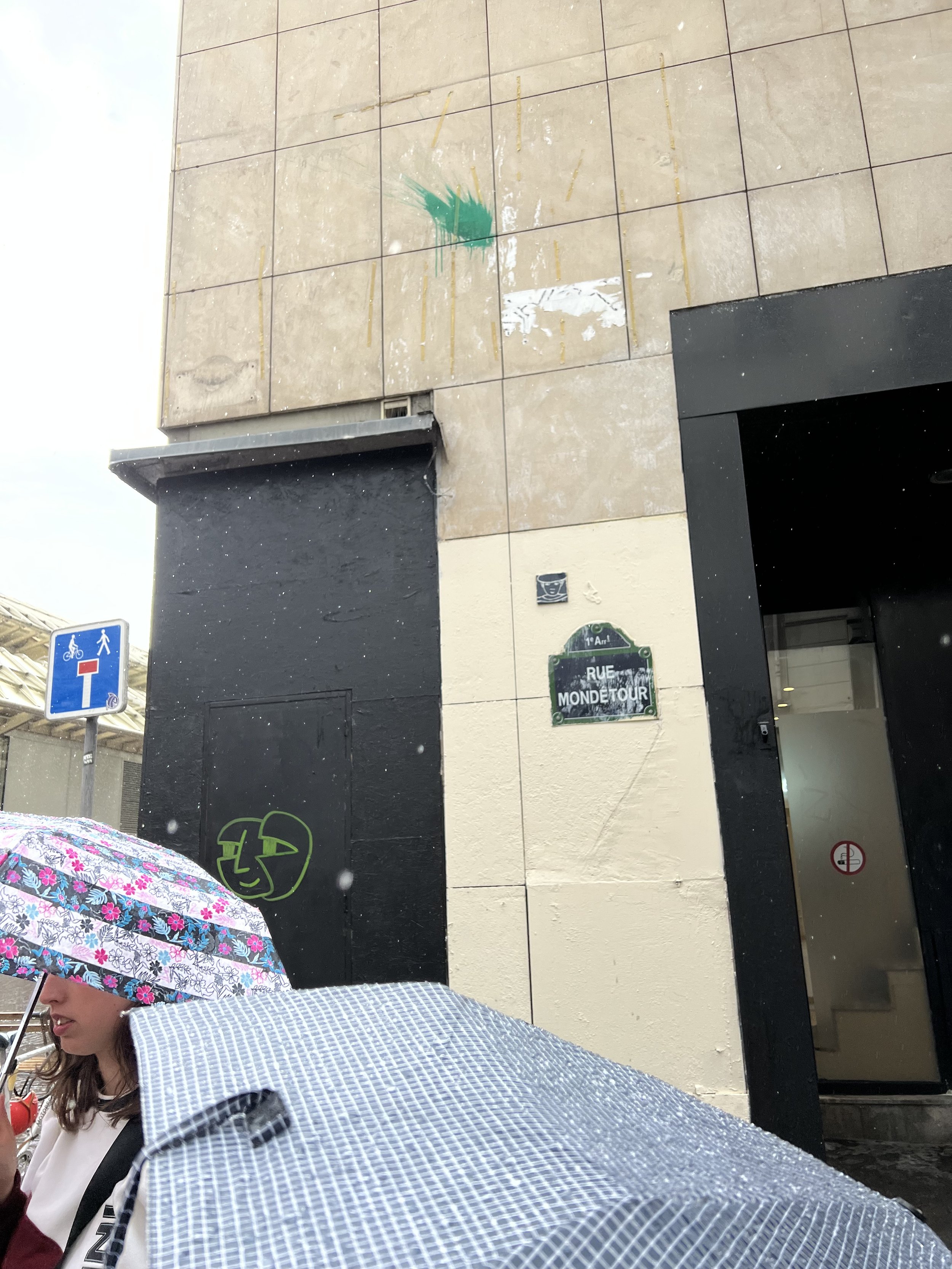We all know the Seven Wonders of the World, but one of the less celebrated miracles of Earth is the weather in Paris. I have been repeatedly taunted by the weather app as I have set out for our adventures umbrella-less only to find that the “10% chance of rain” has become instead a torrential downpour, comically complete with booming thunder and zaps of lightning. Under looming slate-colored clouds ready to drench us at any moment, we persevered in the face of fickle weather to bookpack! Today (the 4th) we have found the sites of two exceptional moments in Les Miserables: the bridge where Javert commits suicide and the Society of the ABC’s barricade where the revolutionaries fight for freedom! I will be focusing on discovering the barricade in this blog.
To begin, to aid in his storytelling, Hugo includes descriptions that point out where exactly the barricade was constructed by the young scholars. Hugo writes “-those who want to picture to themselves with reasonable accuracy the blocks of houses that stood at the time near Pointe St-Eustache at the north-east corner of Paris’s Les Halles, where today Rue Rambuteau begins, have only to imagine the letter N with Rue St-Denis running along the top of it and Les Halles along the base, and the two vertical legs representing Rude de La Grande Truanderie and Rue de la Chanvrerie, with Rue de la Petite-Truanderie running obliquely between them” (974). Interestingly enough, this is quite a ways away from the Latin Quarter where these revolutionary students would have lived. Below, you can observe where we have marked in our copy of the map used at the time of Hugo’s writing where this would be.
Here is the map from the 1800s that was used by Hugo at the time of Les Mis
Setting out in a light rain, we walked from the Seine to the barricade. Along this quick journey, the drizzle became an stormy shower, but nothing will deter bookpackers who are on the case! Although much has changed from the 19th century, there are still some roads that a modern bookpacker can use to identify the whereabouts of the barricade. We walked through the cobblestone streets underscored by the harsh patter of rain on umbrellas and the occasional clap of thunder looking for the location of our brave ill-fated heroes’ final battle. Using the Rue de La Petite-Truanderie and its intersection with both Rue Mondetour and Rue de la Grande-Truanderie, we were able to find where the Corinthe tavern and barricade were built and destroyed.
Screenshot of our destination today- check out those street names!
This 1848 Rue de la Chanvrerie barricade was not terribly tall, a less intimidating barricade when compared to the St-Antoine and the Fauborg du Temple barricades of 1932, but it was solid. It was first erected to be about 6 or 7 feet high, mainly from cobblestones and casks adorned with jagged pieces from carts (we can observe this on page 993). Hugo paints a vivid image as to its overnight improvement; “The insurgents under Enjolras’s supervision- for Marius no longer paid attention to anything- had made good use of the night. The barricade had been not only repaired but enlarged. It had been made two feet higher. Iron bars stuck in between the cobblestones looked like couched lances. All sorts of added debris brought from all around gave it a more intricately meshed exterior. The redoubt had been cleverly reworked into a defence wall on the inside and a tangled thicket on the outside” (1057). It is an impressive structure, with its two separate barricade walls, to envision. The two streets blockaded are pictured below!
Hugo describes this Les Halles area as being full of tenements, and calls them “dark” and “cramped”. This part of town was dirty and grubby, but the law kept a steady watch on it. Today it is an entirely different scene to behold. Les Halles features an assortment of small cafes overshadowed by an ugly Westfield mall & bustling metro station. Given that not much has been kept of the “Old France” and there are many new streets, it took a considerable amount of imagination for me to visualize what this battle would have looked like. When comparing this particular adventure to endeavors where our destinations still retain old monuments or other tangible, standing glimpses into the past, this location required considerable mental imaging to envision. With the rain pouring down, I closed my eyes and envisioned climbing those stone steps of the barricade to peer across at the guardsmen. I pictured Enjolras, Combeferre, and Courfeyrac directing their fellow freedom fighters outside, while Javert awaits his demise inside. I thought of Grantaire drinking in his corner, accompanied by Pere Mabeuf’s ghost. I saw Marius’ unknowing kiss for Eponine as she died protecting him at the barricade. All of these moments from the story were from a past that no longer presses on the minds of the present, but continues to influence us to this very day.
Rue Mondetour! One of the intersecting roads to the barricade.
Within minutes of reaching the barricade, the clouds stopped their crying and Helios began to shine again. The stony streets glowed as the sun reflected her beams, the whipping winds slowed to a gentle breeze. The people folded their umbrellas, laughing at the impermanence of the stormy conditions. Just as quickly as a barricade is built, it can be torn down. How quickly a life can become a ghost, but what a pleasure it is to believe in something and to enact real, rippling change! “ You can hardly tell, an hour after a storm, that this fair beauty, the day, has wept” (Hugo 1093).




